Highlights
While the impacts of COVID have certainly not disappeared, the second quarter in many ways marked a transition. With economic reopening and many people returning to “normal” activities, economic activity and employment have picked up meaningfully, along with inflation.
Yet, many of these statistics are being biased by what is known as the “base effect.” They are often being measured year-over-year relative to suppressed values during the early parts of COVID crises. We see this effect both in economic statistics, as well as trailing returns looking back over the last year.
The Federal Reserve and other global central banks continue to remain accommodative. The Fed has kept short-term rates unchanged, and indicate their analysis shows the current inflation levels are likely to be transitory in nature. They have communicated their intent to maintain their stance and evaluate new data, as they seek to fulfill their mandate to promote maximum employment and stable prices.
Second Quarter Market Summary
Stock market returns were positive across all major geographies. The US generated the strongest gains, while international developed and emerging markets also advanced.
After facing headwinds during the first quarter, bond returns were also positive during the second the quarter. Intermediate and longer-term interest rates have pulled back modestly after peaking in March, while short-term rates have remained unchanged
US Stocks
The US stock market appreciated nearly 8.3% during the 2nd Quarter, and 44.3% over the past year. While value and smaller cap names had a strong run over the prior two quarters, large cap growth showed strength during the quarter. Small cap, and in particular small cap value, has meaningfully outpaced other styles over the past 12 months. Real estate investment trusts (REITs) performed well during the quarter, while modestly trailing the broader equity market over the last year.
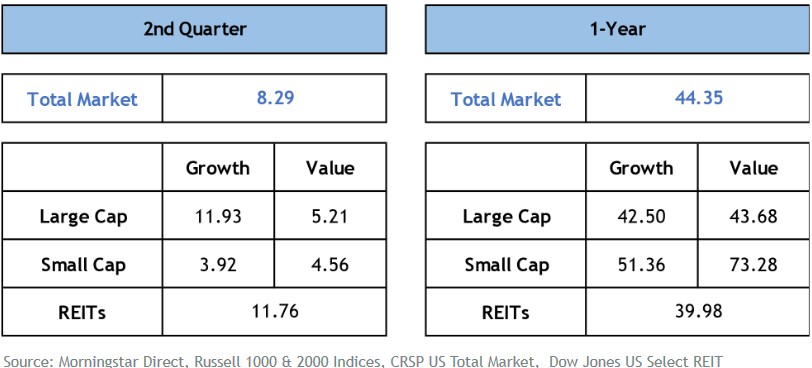
International Stocks
International stocks also gained during the quarter, appreciating 5.2% and 5.1% for developed and emerging markets, respectively. Over the past year, emerging markets have returned 40.9%, outpacing the 32.4% gain for developed markets.
While vaccination rates vary widely across the globe, progress continues, and many major economies are rebounding along with the United States. Absolute returns across all areas have been strong over the last year, with Canada and emerging markets standing out as particular areas of strength.
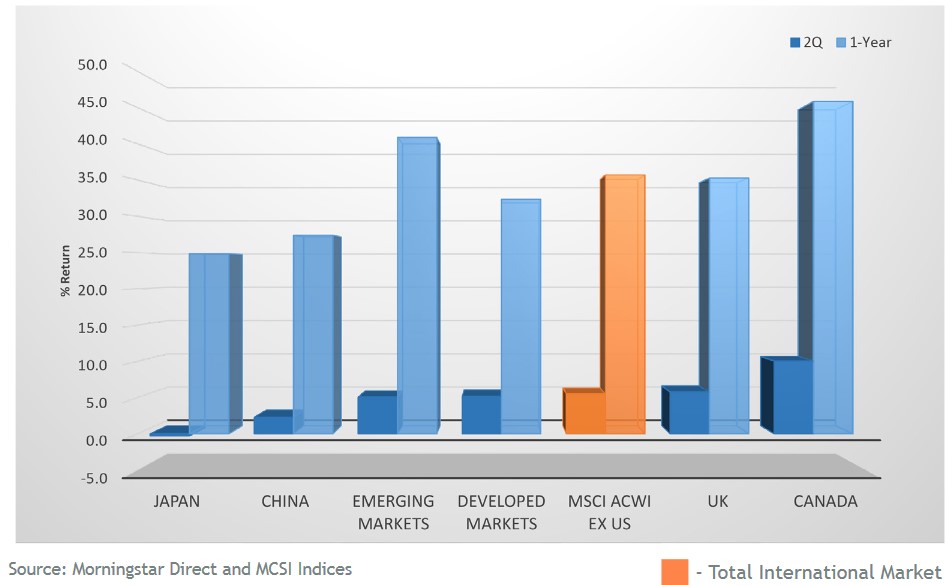
Bonds
Rebounding from the first quarter, returns were also positive across investment grade fixed income sectors during the second quarter. While the short end of the yield curve remains near zero, intermediate and long-term interest rates have generally declined after peaking in March. Municipals and corporate bonds have been the strongest performers over the past year. After being the top sector during the market sell-off last year, treasuries have pulled back since. Both the Aggregate Bond Index (U.S.) and the Global Aggregate ex-US Index (international) have been essentially flat over the last year.
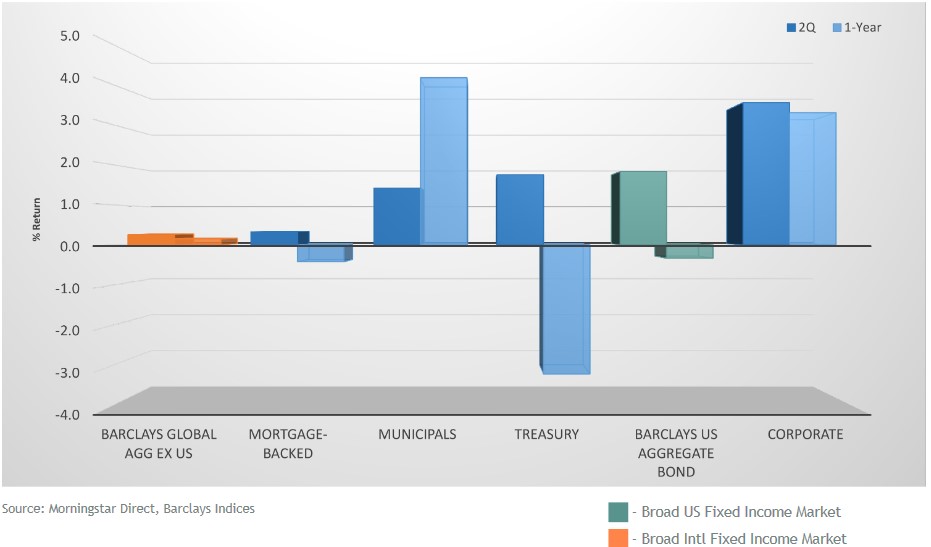
Parting Thoughts
This quarter, we wanted to revisit the importance of global diversification. We know from history that the US and international stock markets trade off leadership over various time periods. When looking at rolling 3-year periods, the US has now outperformed international equities for the last 139 periods (more than decade). Given the length of this streak, investors may question the need to diversify their assets globally. Historically, US and non-US stocks have outperformed each other in cycles that are impossible to predict.
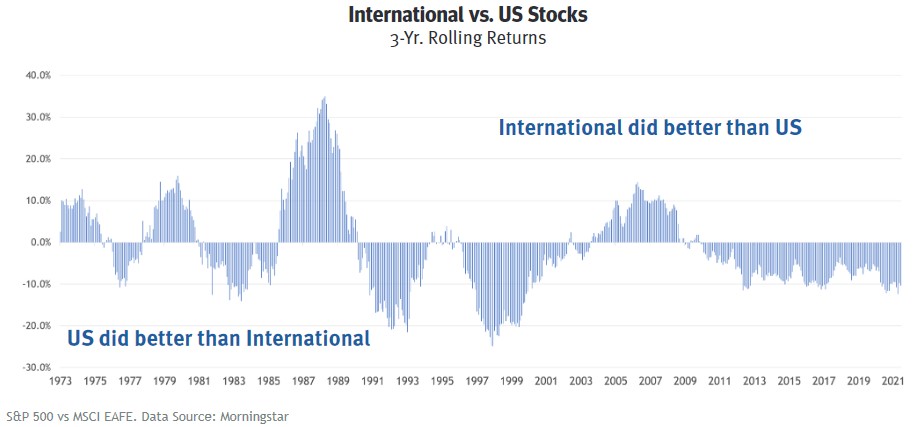
BlackRock, in their Student of the Markets publication, researched deeper into the periods when international stocks outperform. Since 1970, the US market has a slight edge, outperforming 54% of the time. However, BlackRock found that international stocks have tended to outperform during periods when US stock market returns were lower than average. In fact, their research showed that international outperformed in 45 out of 45 ten-year rolling periods where US returns were less than 4%, and 94% of the time when US returns were less than 6%.
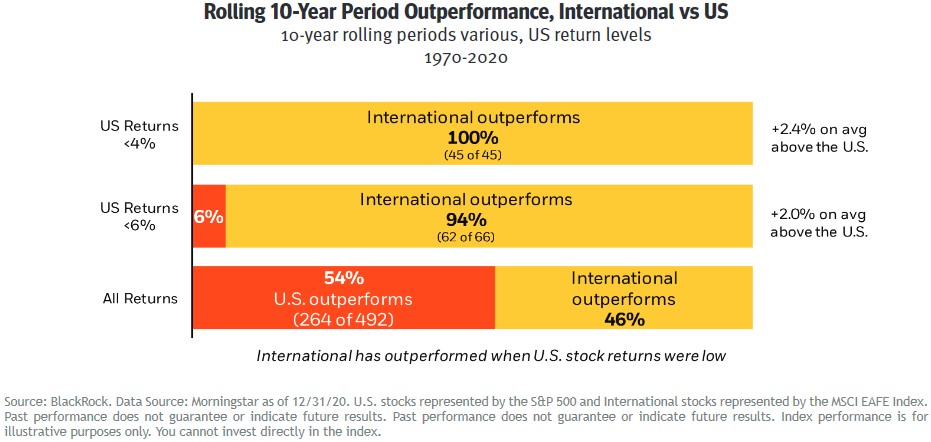
While we know predicting the stock market or timing changes in market leadership is a futile task, given current high valuations for US stocks, it is reasonable to expect returns going forward to be lower than their historical average. If so, the data is clear that international stocks offer a strong ability to add value to portfolios.
Subscribe
Join Our Newsletter
Sign up to receive an email when new articles are posted.
Disclaimer: The opinions expressed in this article are for general informational purposes only and are not intended to provide specific advice or recommendations for any individual or on any specific security. The material is presented solely for information purposes and has been gathered from sources believed to be reliable, however Think Different Financial Planning cannot guarantee the accuracy or completeness of such information, and certain information presented here may have been condensed or summarized from its original source. Think Different Financial Planning does not provide tax or legal advice, and nothing contained in these materials should be taken as such. As always please remember investing involves risk and possible loss of principal capital. Advisory services are only offered to clients or prospective clients where Think Different Financial Planning and its representatives are properly licensed or exempt from licensure. No advice may be rendered by Think Different Financial Planning unless a client service agreement is in place.Your content goes here. Edit or remove this text inline or in the module Content settings. You can also style every aspect of this content in the module Design settings and even apply custom CSS to this text in the module Advanced settings.
